Christmas On the Computer: A Millennial Remembers
memories of a long-gone and strange holiday computer world
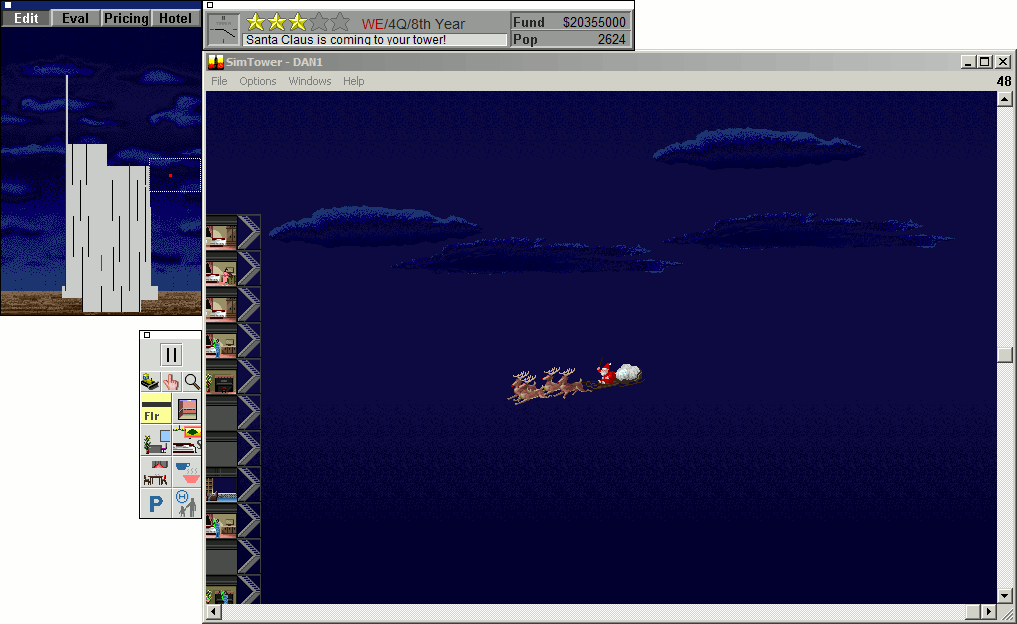
I’m a median-age millennial, of that generation that doesn’t remember the Berlin Wall or Reagan or cheap college tuition, but does remember (as if from a distance) the sound dial-up Internet connections made and comically large cell phones you could play “Snake” on if an adult was willing to let you touch it.
We may also be the first generation to have vivid early-childhood memories of using the Internet. Our goopy little-kid brains were formed in the era in which a first grader could while away the hours Playing on the Computer. By the time we could read and move a mouse around, the world had realized that you could make not just video and computer games for children, but entire websites for the undemanding little idiots as well.
And if there’s one topic that’s guaranteed to hold the attention of wide swaths of American children while not alarming their parents, it’s Christmas. My childhood holiday memories involve the usual stuff (presents, family togetherness, more presents, also presents), but they also are inextricably linked with playing on the computer, in an era where the world had not yet realized that the Internet is full of demons.
Here are some of the things I remember in no particular order.
“Holiday Lights”: Festoon Your 1998 Bondi Blue iMac with Glory
My dad worked for Apple in the 1990s, which meant that I was one of the first children to get my very own bedroom iMac. In between bouts of playing Nanosaur and drawing pixelated dinosaurs eating each other in Kid Pix Studio, I would amuse myself by clicking through the wonderland of shareware on the CD-ROMs that were shipped with each issue of MacAddict Magazine.
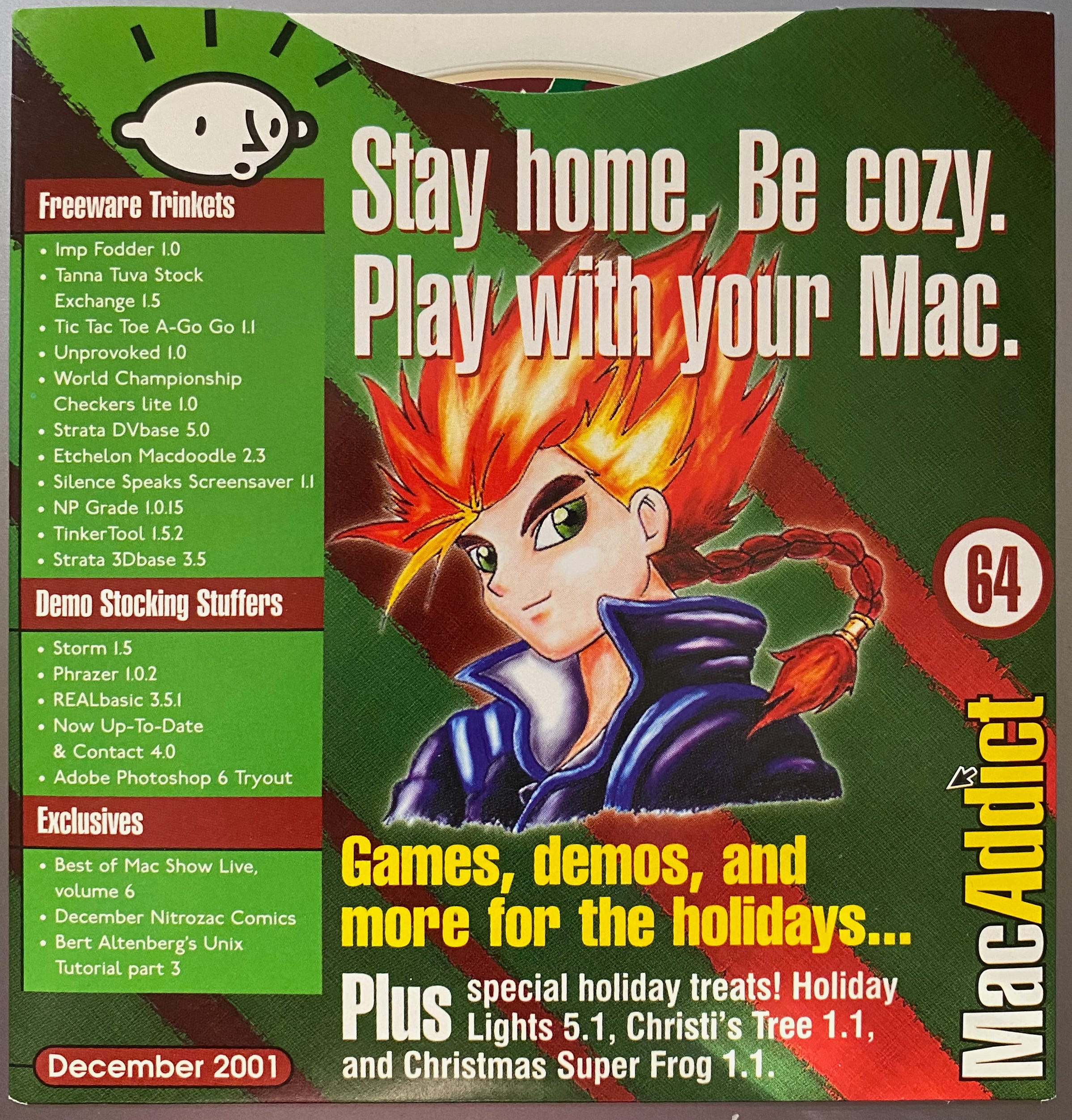
I’d been reading Mac Addict since it first came out in 1996, and I especially loved making off with the free CD and hoarding it like particularly dweeby treasure – psychedelic background wallpaper, weird shareware games, incomprehensible utilities! One year, I am 98% sure that the Mac Addict CD-ROM came with a copy of Holiday Lights, which arrived in 1999 and is a somewhat updated version of an even more ancient 1993 utility called “Xmas Lights”.
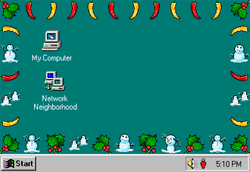
You use it to add an array of Christmas lights around the edge of your screen, which sounds simple enough. But there was depth to it. There were many different bulb varieties, from rainbow dreidels to tiny chili peppers. There was MIDI music. The lights can be rearranged, animated in sequences, and timed. There was even a Bulb Factory which allowed you to make your own customized bulbs, which I did, and they were also dinosaurs eating each other. It was phenomenally annoying for most sane adults. It was a sea of wonder for easily-entertained children.
Then there was Snow, which included a simulated blizzard and similar tinny MIDI Christmas music that is now seared into my brain. Snow accumulates on your desktop. The snowflakes drift. Santa and his sleigh dance across the stage. It is the 1990s and the horror of the post-2016, post-2020 world is still very far away.
This video is a delightful rundown of these ancient Mac utilities.
You can download it here, if you have a Mac emulator set up. And I am feeling very tempted.
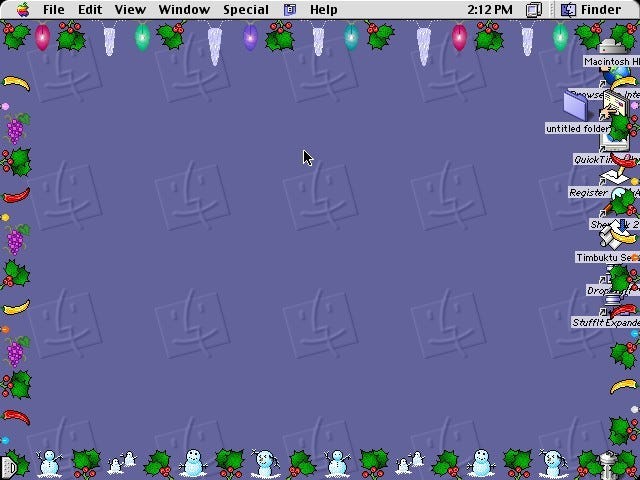
Northpole.com and Claus.com: The Santa Internet
On the 1990s child-friendly holiday Internet, two websites reigned supreme: Northpole.com and Claus.com. Let us explore Claus.com first, because I liked it more.
Founded in 1995, Claus.com is somehow still alive and functional, with a design aesthetic that appears almost totally unchanged from when I was clicking around it. By 1998, when I remember this site most vividly, the art had taken on a more edgy and late-1990s-esque aesthetic. One could fairly say these elves and reindeer were a bit sleazy.
The guy below is, I’m informed, called “Pepper Minstix": he’s the surveillance-minded head of “Elf Control” and is “from a faraway land of mystical elves... the land of the Moorish Knights and Conquistadors. Spain.” (Is Pepper a colonizer?)
In his surprisingly lengthy background story, we’re told that Pepper is in charge of ensuring that children don’t discover the existence of Santa’s village: in this dystopia, humans send out high-tech stealth Village search patrols to smoke out the shadowy denizens of the North Pole. Ultimately, we’re told that Pepper ends up using a gigantic amount of candy that looks vaguely like snow to conceal the village from human air patrols.
And this was, I’m pretty sure, written before 9/11.
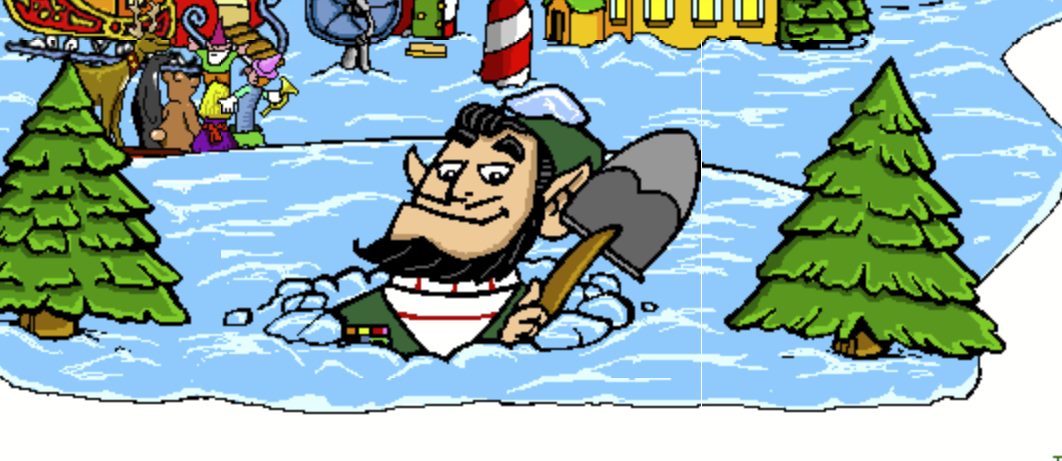
The central navigation, like most of these sites, revolved around a cartoon pastiche of Santa’s village. Corporate sponsors lined the bottom of the page, reminding you who kept the goddamn lights on in Santa’s village.

These websites were remarkably popular with Millennial-aged children who were old enough to be plunked in front of a computer by their parents. By 2002, per this New York Times piece, Claus.com was attracting 9.5 million visitors a year. That’s a substantial number of children experiencing holiday cheer via the Internet, in the era before iPads.
Clicking through the preserved-in-amber website (like a primordial mosquito) is a journey through the world as it was in the late 90s and early 2000s. Click on Mrs. Claus’s Kitchen and you’ll find plenty of bizarre recipes, sponsored by Keebler. Look at this “Not Even a Mouse Salad” and consider that at some point in the last 25 years, a child has demanded to make this, and an adult has had to pretend to enjoy a pear with Red Hot candies and licorice stuck into it. That’s probably a war crime.
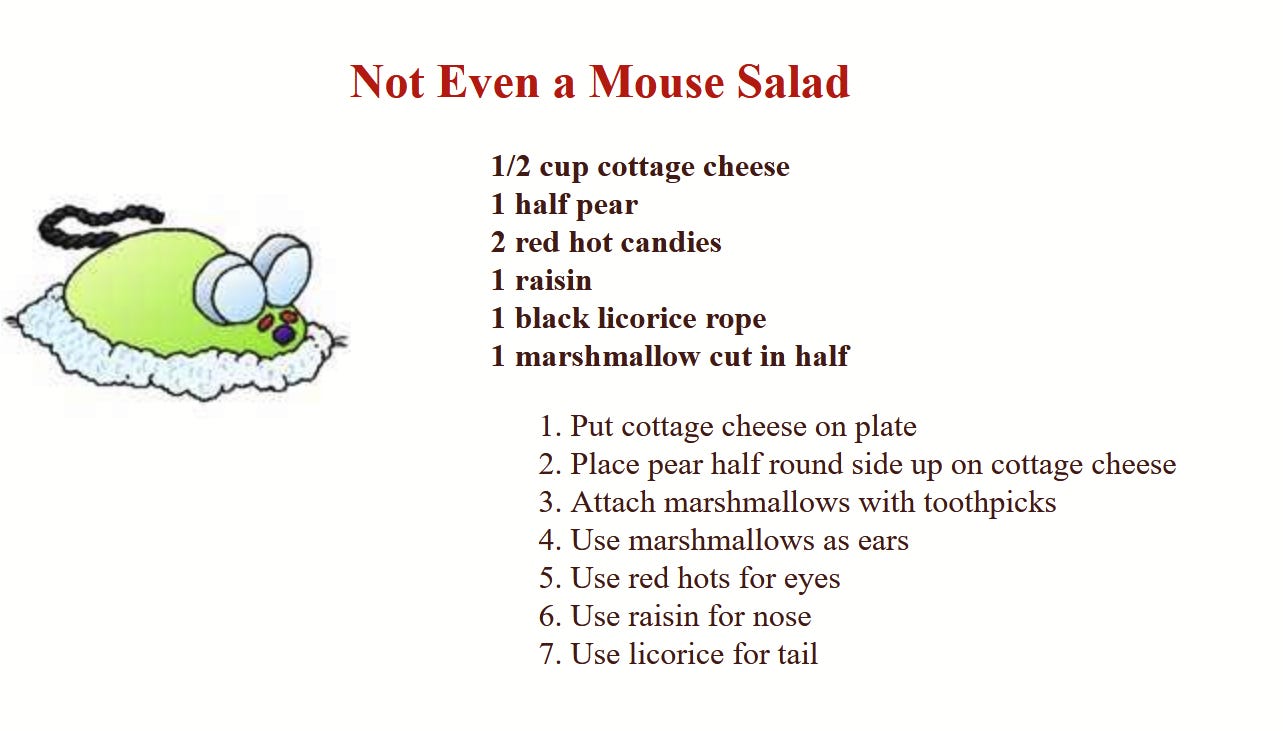
Every kid’s Christmas website included a function by which children might, with the newfangled power of the Internet, send letters to Santa. Both Claus.com and Northpole.com reassured children that Santa would write back within four days: I never did this, because I was pretty sure, even as a child, that it was some kind of automated scam.
This 2003 trend piece on the phenomenon of Santa On the Internet indicates that the websites relied on form-letter software to keep up with the volume of hopeful emails from kids who wanted a Gamecube. As of 2002, NorthPole.com claimed it received over 300,000 pieces of Santa-related email each year. (The piece notes that even Amazon ran a kids Christmas site for a while, at http://www.northpolesantaclaus.com/ - although no signs of this still persist on the Internet Archive).

You might also visit the Reindeer Barn, where, by the conceit of all kid’s media, the reindeer were assigned appropriately sterotyped personalities. (There doesn’t seem to be a Rudolph. These people were, apparently, traditionalists).

In retrospect,some of these reindeer come off as, uh, more queer-coded than I realized at the time. Donder is something of a ungulate butch icon.
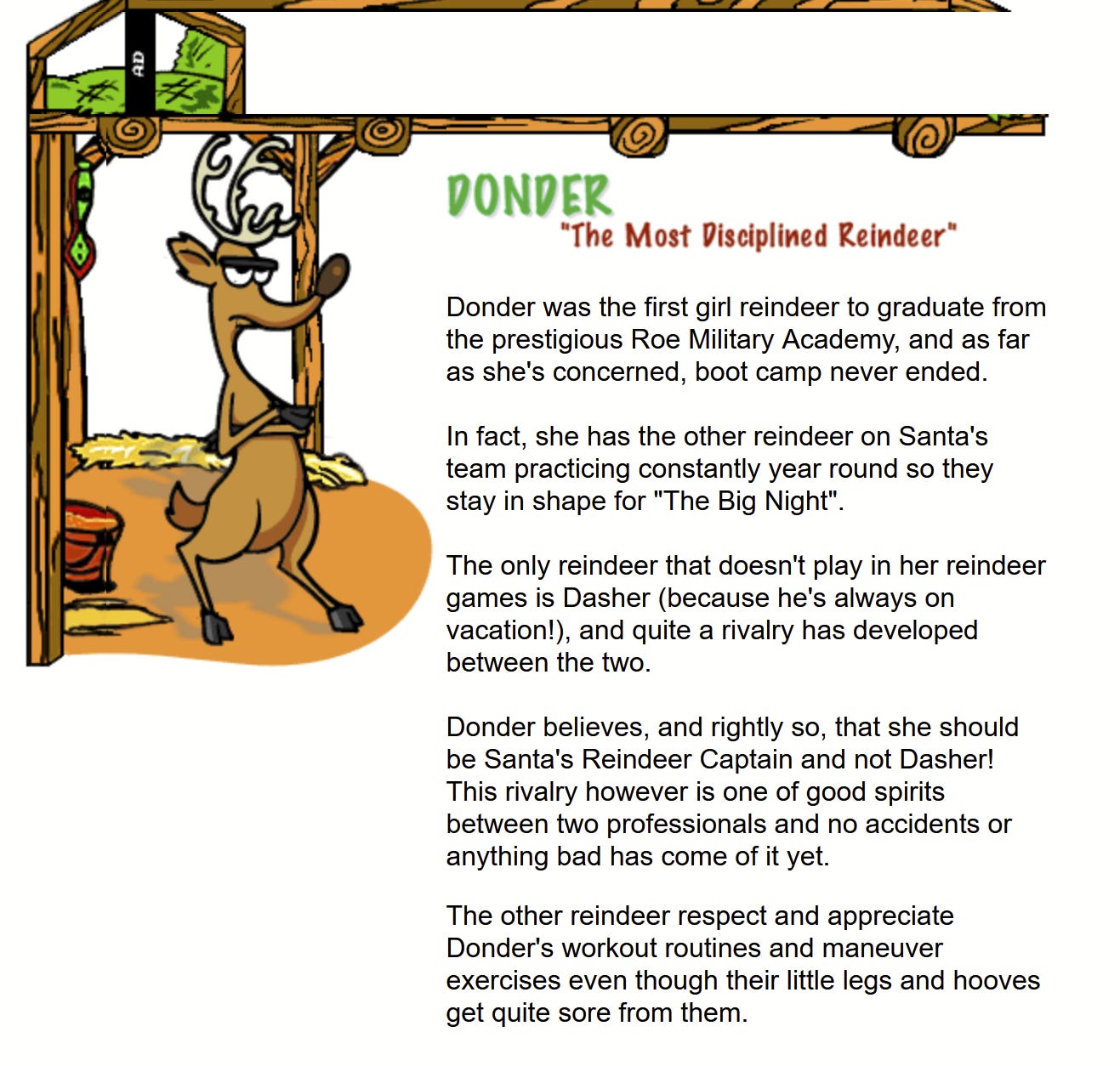
Clicking on Santa’s freakish hat-shaped house reveals to us that Santa is, for some reason, the owner of a fleet of mid-range Chevy vehicles - and you, the child-user, were invited to Elfinize them. (That’s a verb that I’d like to get more people to use, since we live in the end-times anyway). Here I have, with the raw power of technology, elfinized a 2002 Chevy Trailblazer.
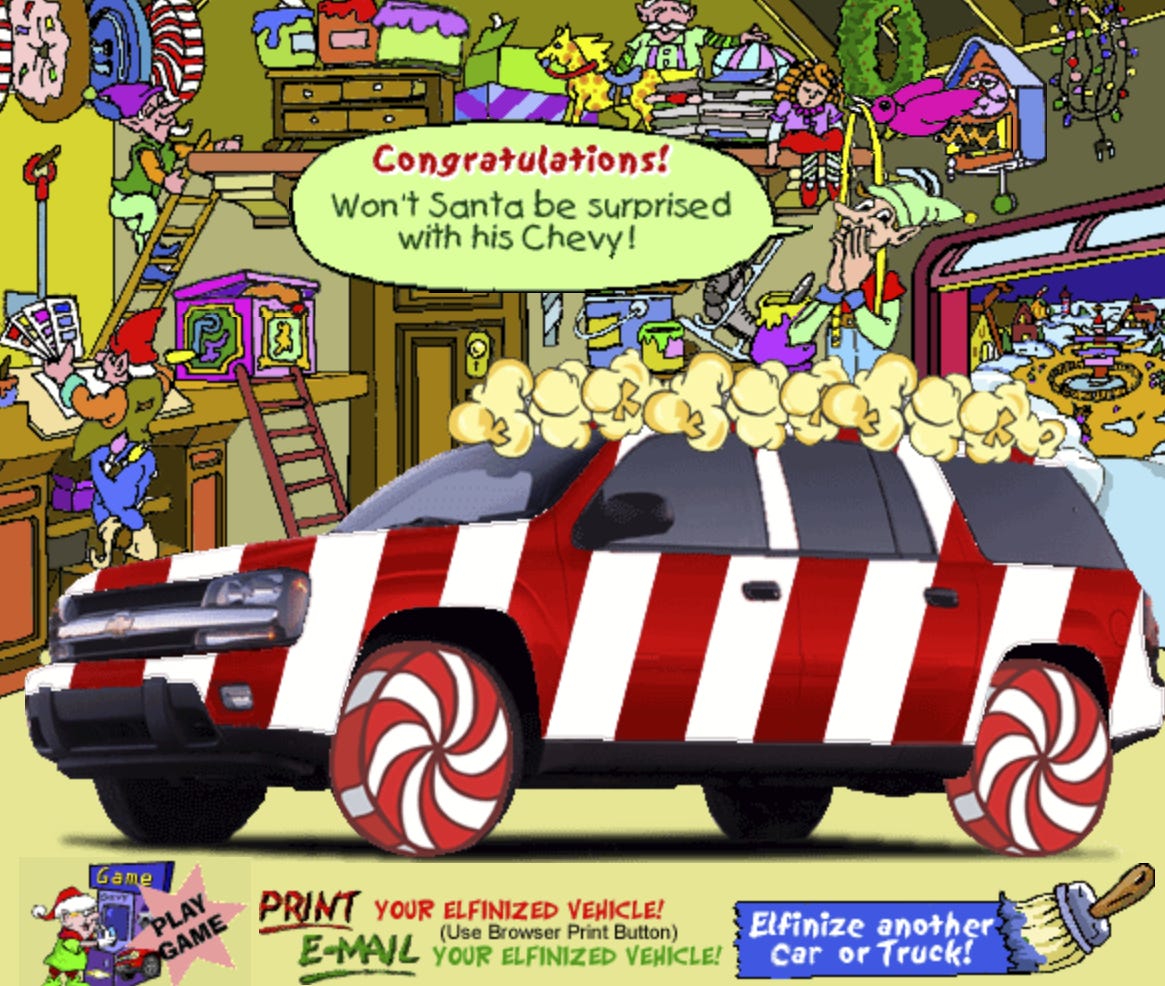
Finally, we come to a child’s most nerve-wracking pre-Christmas preoccupation: the Naughty or Nice Judgement Day, the great moment in which an omniscient hermit clad in red determines if you get a Gameboy Color for Christmas. In the Claus.com extended universe, Santa has outsourced managing this process to a ski-slope nosed elf, though he’ll still deliver the final assessment of your character in person.
The system is, as you might expect, randomized: the same child’s name will barf out various levels of Nice results, usually with some admonishments to work on typical annoying child behaviors like having a dirty room, watching too much TV, and being a dick during the month of February.
In retrospect, this prepared my generation well for an adulthood of being endlessly judged by arbitrary computer algorithms whose workings are concealed to us. Santa’s Nice or Naughty List is a black box, and the box only pretends to care about you as an individual.
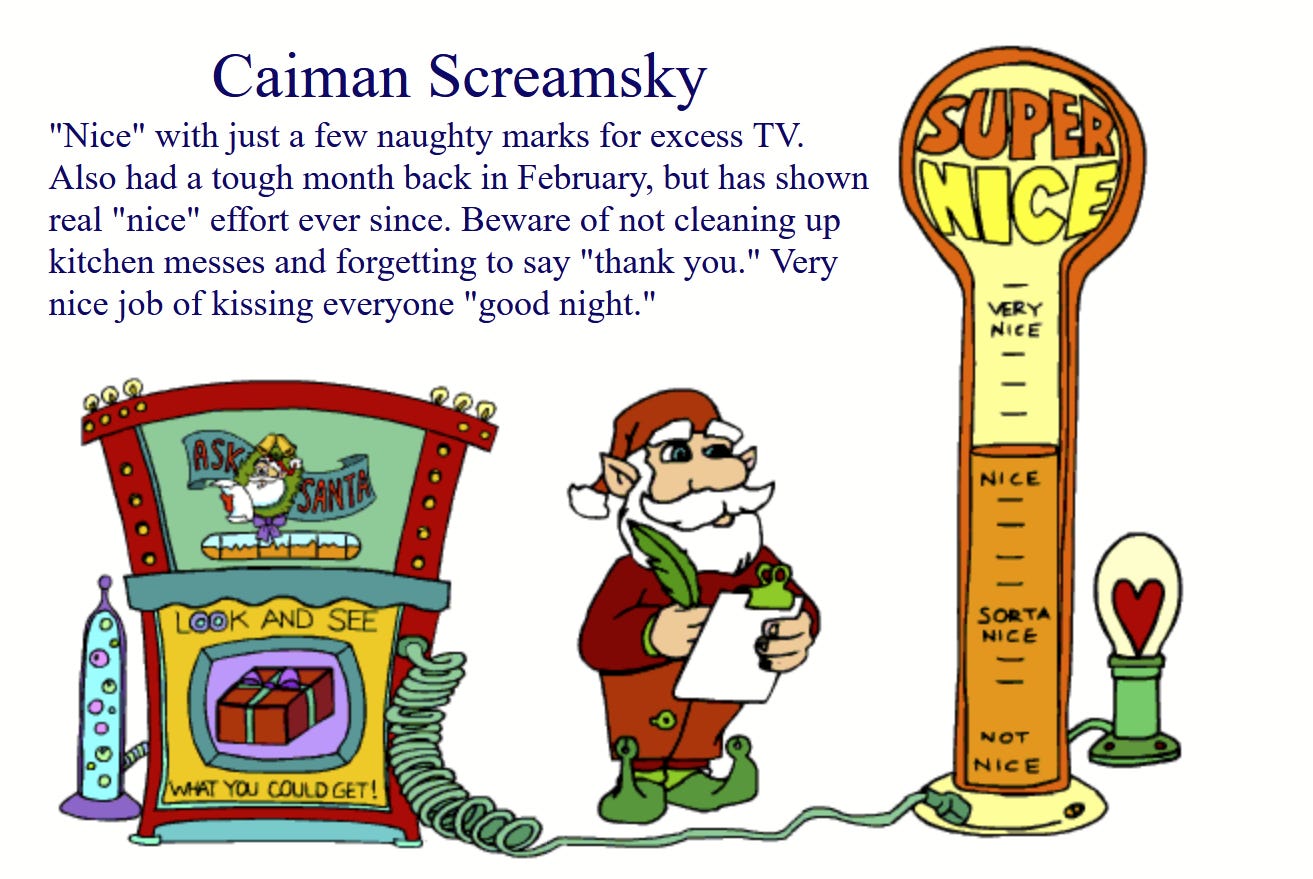
Santa will also creepily note that you did something bad on a *specific day or month*. Sometimes, the child is informed that they only just barely squeaked through onto the Nice list, and that Santa is watching intently for any regressions to the slovenly mean. And people blame millennials for being wracked with anxiety.
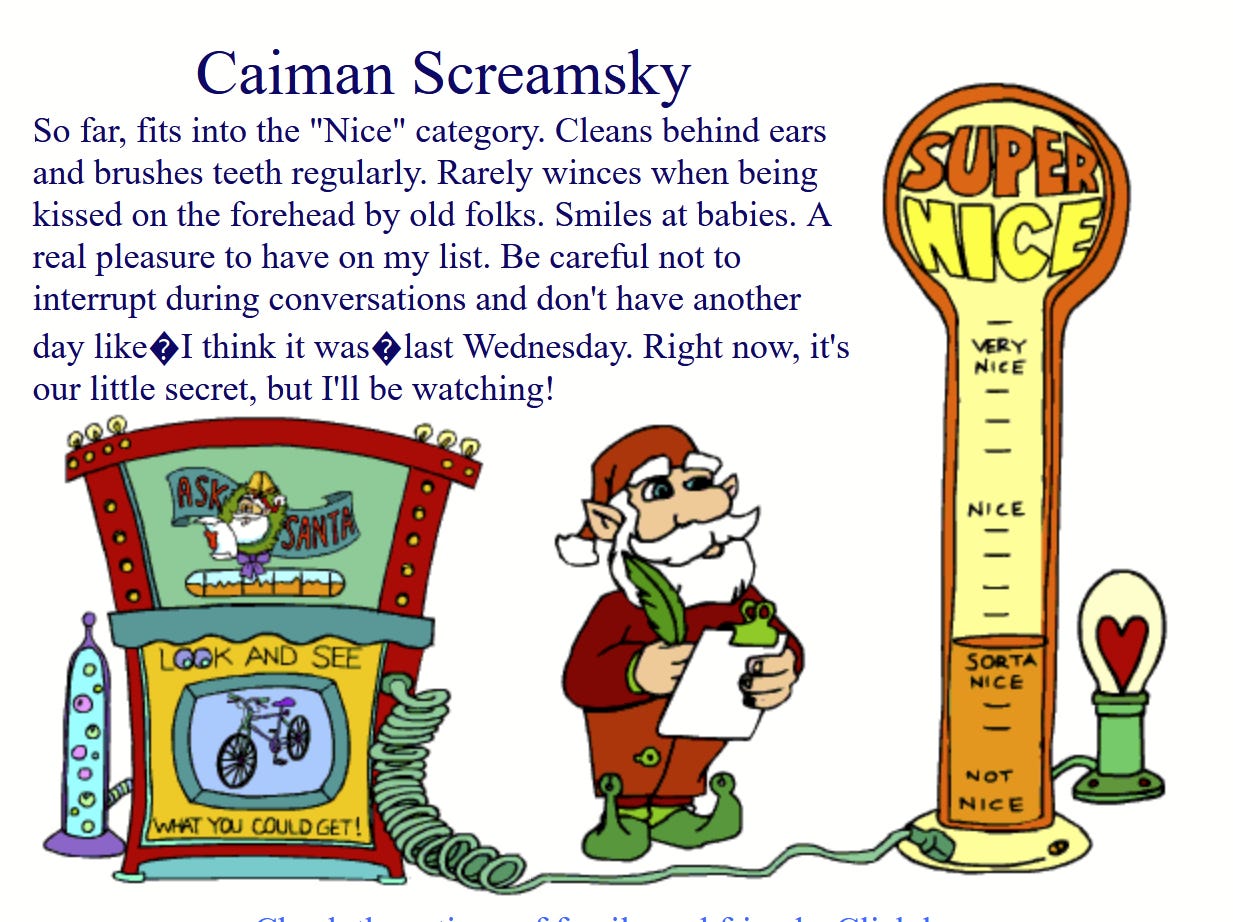
Northpole.com is also, incredibly, still alive and functional. During Christmas 1997, the place looked like this, and it’s almost exactly the same today, in the heinous pandemic year 2021. I am shocked that someone, somewhere, is still paying the server fees to keep these things alive and almost entirely functional.
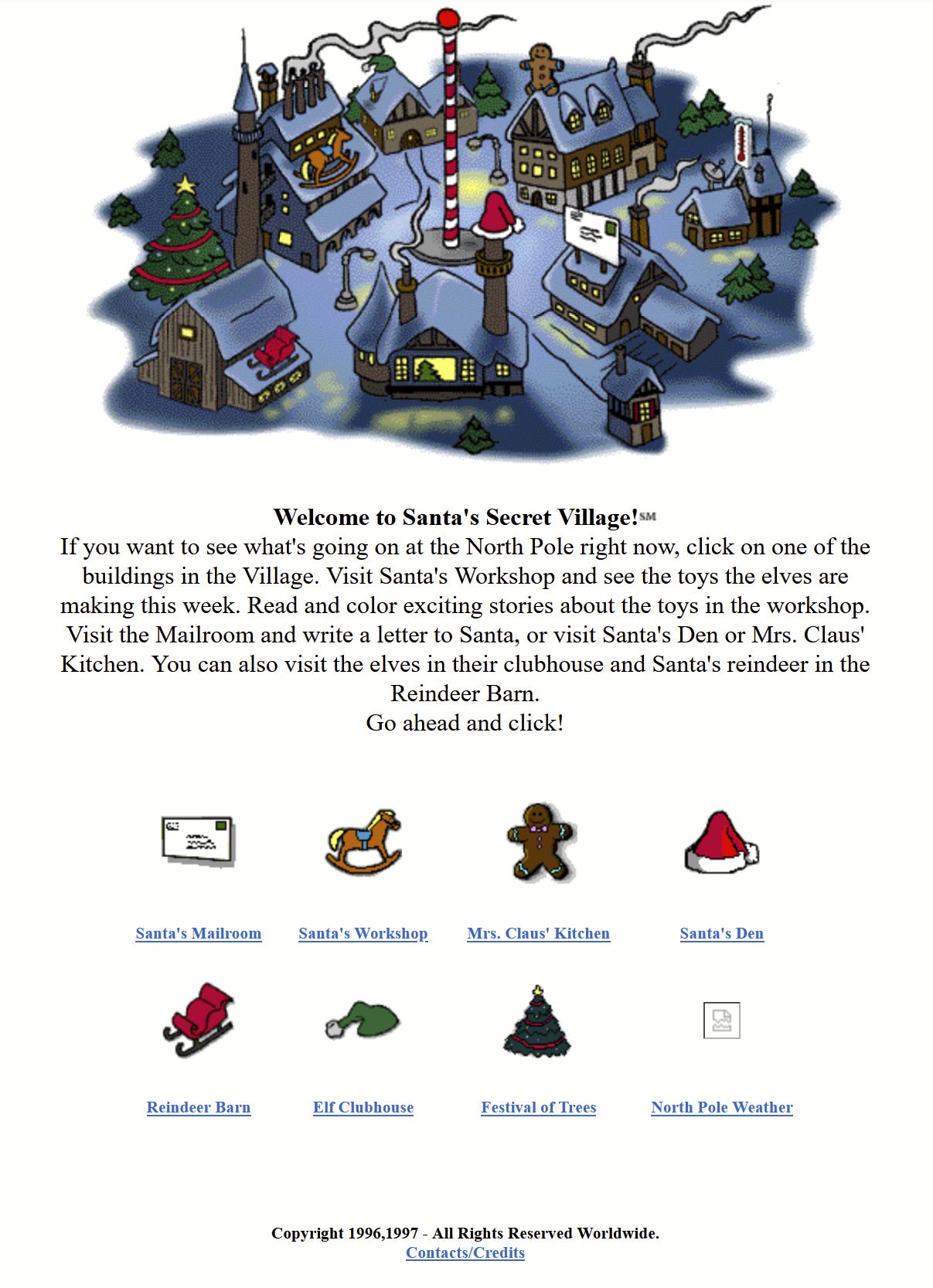
Northpole.com always had a more restrained, sedate character than Claus.com. The illustrations were sanitized and soft-edged, something you’d find in a preschool I Can Read book your teacher assigned you. In other words: kind of lame. No one was using the word “Elfinize.”
A key feature of 1990s and early 2000s children’s website: Click Around The Thing To Find the Hidden Things. At the time, this sort of key-jangling shit could hold my rapt attention for weeks. My undeveloped and innocent brain swiftly learned that the Internet was a magical land of little hidden secrets, and I was good at finding them.
In retrospect, this may have been a bad lesson to teach little kids.

The Reindeer Barn at Northpole.com centers around the exploits of a rather dickish baby reindeer named Raymond. (Raymond the Reindeer. Pathetic).
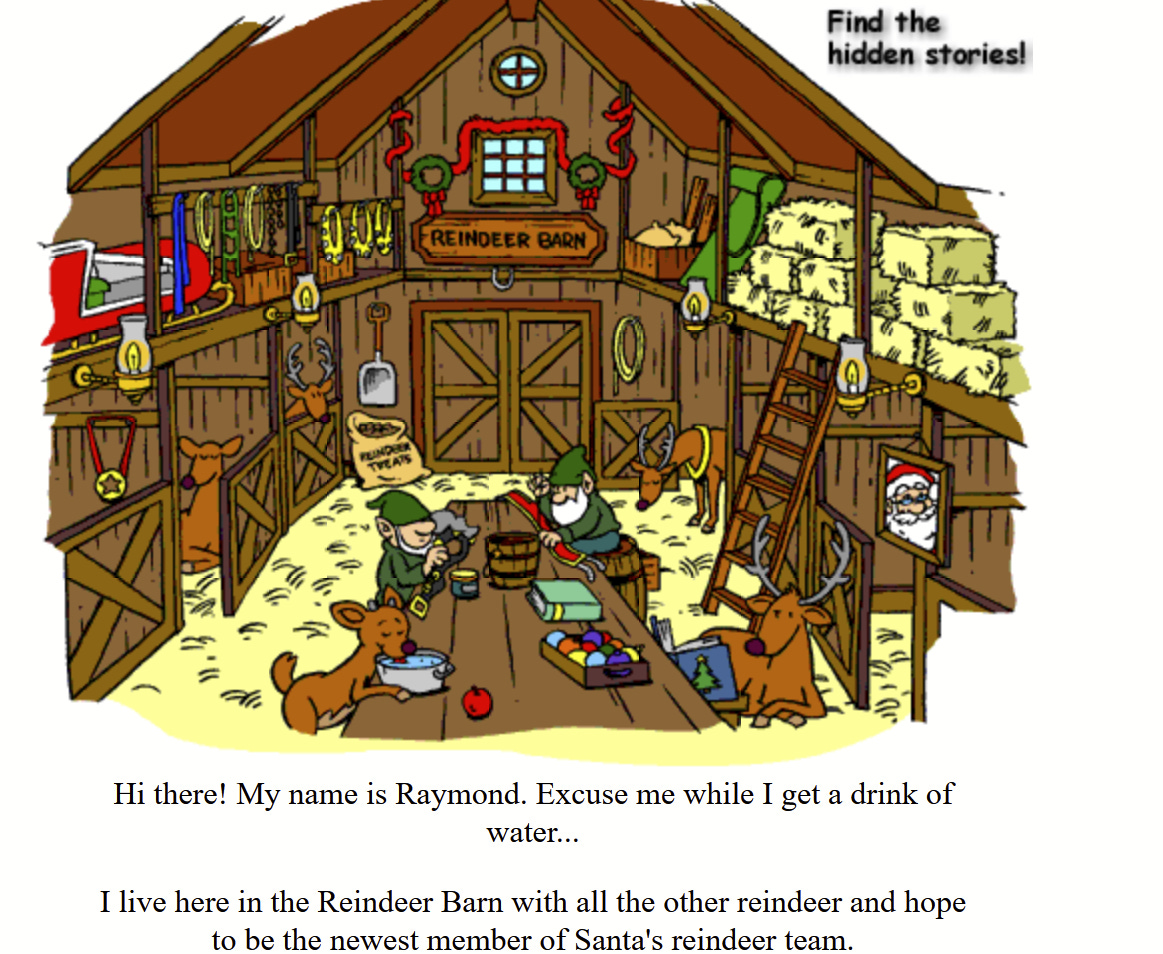
His exploits include getting lost on Christmas to great general consternation, being nice to his grandmother, bragging about being good at sports, and eating too much. The last of Raymond’s boring adventures forces him to miss the Reindeer Dinner as he’s eaten so much junk food that he feels like three-week-old ass:
it ends with Raymond, alone, watching his friends play through a window, a single piece of candy his only comfort. This is some rather bleak shit for a children’s story about a reindeer.
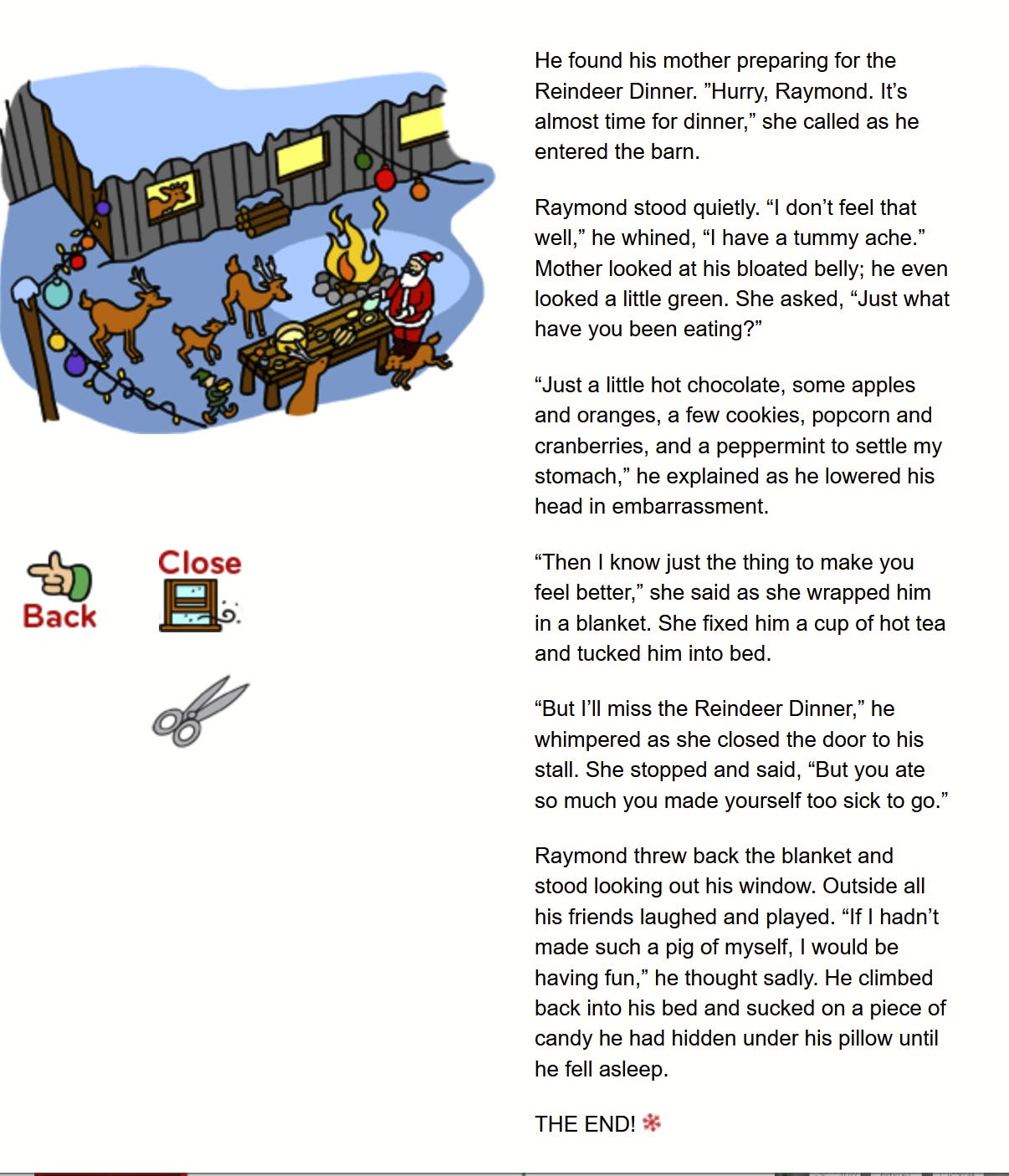
The Santa’s Workshop in Northpole.com features a number of mostly boring stories about toys and games: however, traces of the techno--optimism of the late 90s and early 2000s still shine through. Like the one where Santa creates a magic-powered drone.
After extreme weather threatens to ruin the avaricious-children to Santa wish-list delivery pipeline, Santa realizes that his workshop is lousy with model airplanes, trucks, and ships. And thus, with some “magic dust",” Santa winterizes the models and imbues them with some sort of doubtless deeply unnatural artificial intelligence.
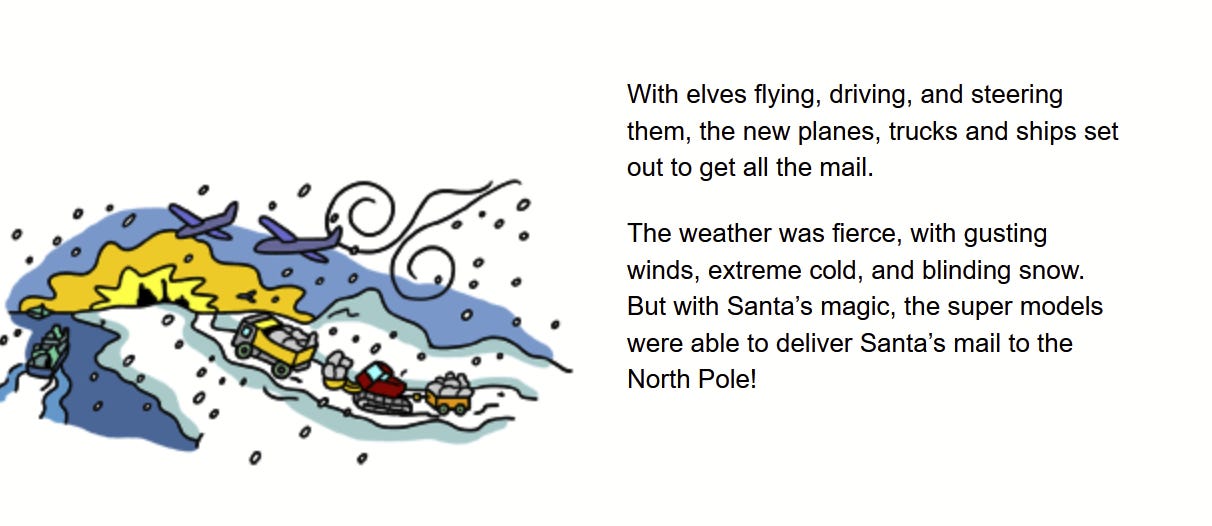
The NORAD Santa Tracker: Online!
Both of the Christmas websites I’ve featured above have certain curious undertones of American technological superiority woven in with all the shit about peppermints and tiresome little reindeer. But none compare to the North American Aerospace Command (NORAD), which has been pretending to track Santa Claus through the skies with defense satellites since 1955.
In NORAD’s version of the Santa Claus extended universe, sure, there’s Christmas magic, improbably through present distribution schemes, and flying reindeer. There are also devastating nuclear weapons that will turn your eyeballs into jelly. One wonders how children were supposed to reconcile all this with the Claus.com vision of Christmas dystopia, in which fighter jets are regularly scrambled to prove Santa’s existence and thus ruin him entirely.

You may be wondering why the fuck a shadowy Cold War missile defense organization got into festive children’s entertainment. Legend has it that a Sears Roebuck ad directing kids to a fake-Santa line transposed a number and actually connected them to an early version of NORAD, whose members grew so overwhelmed by the sea of disappointed children that they made up the Santa thing on the spot.
In truth, some bored wag at NORAD during the holiday season drew a picture of Santa Claus on a tracking board, and Colonel Harry Shoup picked up the ball and ran with it, telling everyone that his people were surveilling Santa’s Cold War-era movements to protect him from enemies who “did not believe in Christmas.” The idea took off, and radio, newspapers, and TV began collaborating to release official-sounding reports on Santa's progression. Here’s one such report from the 1980s:
The below, brand-new NORAD Santa Tracker video is a remarkably slick production that tells children that Santa’s progress is tracked “using the heat signature from Rudolph’s nose”: these Santa location updates are “sent to our elite fighter pilots, who intercept and escort Santa’s sleigh through American airspace.”
Congratulations, America: we’ve managed to militarize the magic of Christmas.
And we’ve given children a lingering fear of anti-Santa armaments.
In 1997, the Santa tracking business moved to the Internet, and that’s when I made my own childhood acquaintance with it. In 2000, the enterprise started making 3D-animated “Santa Cam” videos that show a live gifts-to-home pipeline, and they’d eventually partner with Google to provide ever-more-elaborate satellite and aerial imagery for Santa to virtually chuck presents at. Such as this 2014 video in which Santa flies cheerfully over a palm-tree filled and totally empty 3D version of Kandahar Military Base in Afghanistan. With a very large Christmas tree smack-dab in the middle of it.
The 1997 iteration of the site was far more low tech. You’d track Santa’s global progression via regularly-posted updates and photographs, taken by some combo of high-tech satellites, radars, and jet fighter cameras, a live stream of content that ticked down the time until Santa drew excitingly near to where you actually lived.
I work in a geography-related field as an adult - I make maps with drones - and I do partially credit the NORAD site with my current career path. Certainly at the time, as a kid who sort of still believed in Santa, or at least enjoyed playing along with the conceit, I enjoyed opening up the browser and watching Santa’s progress through the sky.
I’m sure most parents like the NORAD Santa Watch too, as long as they don’t think too much about the implications of their children watching Santa glide serenely over, say, a US military base in 2007 Baghdad. (That happened). It’s a computerized bed-time mechanism, government-sanctioned that Santa Claus is drawing nearer and that children should get into bed so the adults can drink Chablis. Oh, look! He draws nearer, and nearer still! Consider the vast expanse of US surveillance power and its dominion over magic! Or whatever! Please pretend to sleep!
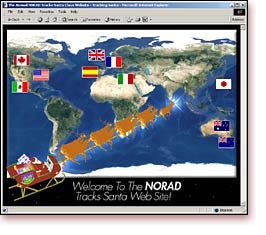
I’d show you the original in all its low-resolution glory but the vintage versions of the NORAD Santa Tracker has been ruthlessly purged from the Internet. The Wayback Machine doesn’t have it. Just a few screencaps on the somehow-still preserved old website of AGI (Analytical Graphics), which helped NORAD produce the earliest Santa Tracker sites, remain.
In 2021, the Norad Tracks Santa website is a glitzier affair than ever, though it retains quite a bit of the janky charm that you’d expect from a government missile defense agency project intended to delight and amuse children. Buy a t-shirt. Watch animated elves skate. Play festive web-games.
Wonder, as an adult, if Santa Claus will be making a close-in visit to Afghanistan this year.
